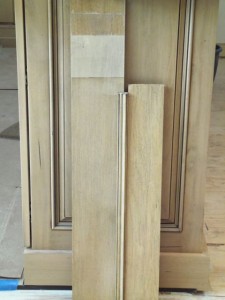Painting in Partnership, from the Chicago area, was recently faced with an unusually high wood finishing challenge: Matching a factory-applied, six-layer lacquer cabinet finish unto two doors, casings, railings and baseboards. Everything had to be field-finished and spray equipment was not an option. Achieving an “exact” match was part of the requirements for this job.
As you may know, lacquer dries almost instantly and each coat melts into the previous one. The cabinet manufacturer had given us the products to use for the wood finishing. However, we could only use two of the products: the toner and the glaze. We had to separate the toner coat from the glaze coat with two layers of Enduro clear waterborne urethane made by General Finishes. Why did we use two layers: any holidays or shy areas in one clear coat would have ruined the toner coat when the glaze was applied! How did we get around the quick dry times: by using the skills of two well-coordinated craftsmen! The challenge was especially acute when we painted the twenty-five square foot door.
To complicate things further, the wood used for the cabinets was alder and the wood used for the field woodwork was birch. A clear coat applied over alder wood results in a lovely brownish color. However, a clear coat over birch creates in a much lighter color. Since we were given birch to work with, we had to stain the birch wood to match the color of a sealed alder, so we could start our wood finishing on the same footing as the factory production. We used a quick drying waterborne stain from General Finishes and a seal coat on top of it, before we proceeded with the lacquer toner.
In all, eight layers were needed to create the desired matching finish. Our craftsmen at Painting in Partnership are experts at using cutting-edge products and technologies to meet the most challenging of our clients’ needs, that they involve wood finishing or any other aspects of painting and decorating or historical restoration.









 Follow
Follow
